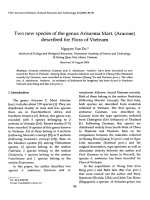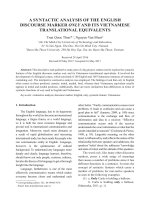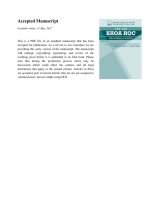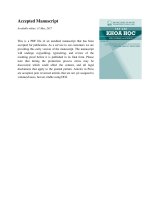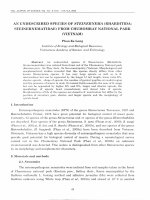DSpace at VNU: High Energy Scattering of Polarized Nucleons with the Phenomenological Spin – Orbit Potential
Bạn đang xem bản rút gọn của tài liệu. Xem và tải ngay bản đầy đủ của tài liệu tại đây (513.99 KB, 12 trang )
VNU Journal of Science: Mathematics – Physics, Vol. 32, No. 4 (2016) 68-79
High Energy Scattering of Polarized Nucleons
with the Phenomenological Spin – Orbit Potential
Nguyen Nhu Xuan*
Department of Physics, Le Qui Don University, Hanoi, Vietnam
Received 02 December 2016
Revised 16 December 2016; Accepted 28 December 2016
Abstract: The scattering amplitude of polarized nucleons has been found within the framework of
the Klein – Gordon with the phenomenological spin - orbit potential. It has the Glauber type
representation. The differential cross sections of polarized nucleon are considered and discussed.
The Yukawa potential is applied for this problem to determine the polarization of high energy
scattering nucleons.
Keywords: Glauber representation, eikonal scattering theory, polarized nucleons.
1. Introduction
In two papers of H. S . Köhler, Cern, Geneva [1, 2], he pointed out several measurements, which
have been made of differential cross-sections and polarizations of protons inelastically scattered by
nuclei. Such experiments have been made at 220 MeV in Rochester, at 155 and 173 MeV in Uppsala
and at 135 and 95 MeV in Harwell. A striking feature of these results is the similarity between the
angular dependence of the polarization of particles scattered inelastically by exciting a low-lying level
and the elastic polarization. Even more striking is the agreement between polarizations of protons
scattered inelastically by nuclei of different masses.
In the paper [3], the basic element for an evaluation of the complex spin-orbit part of the optical
potential is the calculation of the complex effective internucleon spin-orbit interaction was considered.
Pervious investigators concerned with the real part of the spin-orbit potential, have taken this effective
spin-orbit force as shortratige in comparison with the effective forces which give rise to the central
part of the optical potential. The reason behind this assumption is the short-range behaviour ofthe spinorbit component entering in the free internucleon interaction, for example the Hamada-Johnston force.
The difference between the effective and the free spin-orbit internucleon force appears mainly near
and inside the core region and is due to the presence of the tensor and higher order components in the
realistic internucleon force and the Pauli principle. The extrapolation of these results to the nuclear
scattering case which we consider does not seem to be straightforward. Similar effects can also be
expected to influence the spin-orbit effective interaction.
_______
Tel.: 84-983328776
Email:
68
N.N. Xuan / VNU Journal of Science: Mathematics – Physics, Vol. 32, No. 4 (2016) 68-79
69
The calculation of the real part of the spin-orbit part of the optical potential for spin saturated
nuclei has usually followed the procedure given by Blin-Stoyle. He found that exchange effects
account for about half the strength of the spin-orbit component of the potential and therefore cannot be
neglected [3].
Moreover, the polarizations which result from the elastic scattering of protons by spin-zero nuclei
are discussed by means of the multiple-diffraction approximation. They are found to depend largely on
the elementary proton-nucleon central-force and spin-orbit scattering amplitudes and, at least for
heavy nuclei, to depend very little upon the remaining proton-nucleon amplitudes which are
proportional to the spins of the target nucleons. In particular, the values of the polarization measured at
small angles can be used to determine the imaginary part of the forward proton nucleon spin-orbit
scattering amplitude. The real part of that amplitude, on the other hand, is much less sensitively
determined by the polarization distributions. Its evaluation will probably require more detailed
measurements on the proton spin distribution. The effects of the Coulomb field on the polarization
distributions are significant at all scattering angles. Included among these electromagnetic effects is
the relativistic interaction of the proton magnetic moment with the Coulomb field. [4]
Scattering of particles included spin s = 1/2 considered in some papers [5-7], but methods were not
complete, or could not be applied for various potentials. In the paper of Kuleshov et al [8] used two –
components method to study scattering of particle with spin 1/2, but the affection of spin to scattering
amplitude was not clearly.
In recent our paper [9], we have used the Dirac equation in an external field to investigate the
Glauber representation for scattering of Dirac particles (spinor particles) in the smooth potential after
using the Foldy – Wouthuysen transformation.
The aim of this paper is to generalize the eikonal representation for the scattering amplitude of
spinor particles at high energy. We used Klein – Gordon equation in non-relativistic approximation in
the form “two-component formalism” to study the scattering of nucleons with spin. But Klein –
Gordon is the second order differential respect to time also it can be transformed into two coupled first
order differential equations after using “two components formalism. We gain several advantages from
of this reduction. First, the equation is now first order equation in the time, so that the time
dependence of the two-component wave function is uniquely determined by its initial value, in
agreement with the rules of quantum mechanics. Second, the interaction of nucleons with spin 1/2 will
be tied to the 2 x 2 Pauli matrices so the use of the two - component formalism will comment
accordingly with spinor matrix structure as in quantum mechanics phenomenology.
Nonrelativistic approximation is used here to separate the classical contribution and the
contribution of the spin into the scattering amplitude, from which we can compare with the previous
results [9]. Also due to the inclusion of virtual potential phenomenology related to the absorption of
virtual nucleon, we consider the more is the polarization of the nucleons in the scattering process.
The paper is organized as follows. In the second section, we obtain the Klein – Gordon equation in
an external field in the non-relativistic approximation by using “two-component formalism”. In
Section 3, we get the scattering amplitude of high energy nucleons with phenomenological spin - orbit
potential. Section 4 is devoted to compute the analytical expressions of the differential cross section
and polarization of nucleons in the Yukawa potential. The results and possible generalizations of this
approach are also discussed in section 5.
N.N. Xuan / VNU Journal of Science: Mathematics – Physics, Vol. 32, No. 4 (2016) 68-79
70
2. Klein – Gordon non-relativistic equation in the external field
The Klein – Gordon equation in the external field with A x - 4 components potential (q –
electric factor included, m is mass of the particle) has form
i A i A m2 x 0
(2.1)
We will now discuss how above equation can be cast into a “two-component” form. This will help
to understand the equation and to study its nonrelativistic limit.
Above equation will be cast into two equations in the Schrodinger equation form
(2.2)
H
t
where is a vector in a complex two – dimensional space and H is a 2x2 matrix [10].
i
The transformation to two – component form can be carried out by introducing two new wave
(r , t )
functions (r , t ) , (r , t ) , which are more symmetric linear combination of (r , t ) and
.
t
1
0
i V m (r , t )
2m t
1
0
(r , t )
i V m (r , t )
t
2m
(r , t )
(2.3)
The choice (2.3) is not unique. It was chosen because it is simple and gives equations with some
features suggestive of the Dirac equation.
With the choice (2.3), now we go into defining a new wave function. It will be organized into a
two – component column vector
(r , t )
.
(r , t )
(r , t )
(2.4)
This vector satifies the first order diffential equation (2.2) with Hamintonian is [10]
( p V )2
0
m V
2m
H
( p V )2
2m
( p V )2
2m
( p V )2
0
m V
2m
(2.5)
( p V )2
( p V )2
m
i 2 V 0
3
2
m
2
m
where p = -i is the energy momentum opeartor. The generalized “potential” interaction consists
of a vertor part V and a scalar part V 0 and i are the Pauli matrices.
In our present study, we obtain explicit relations for the scattering of a non-relativistic particle,
while we plan to consider the corresponding relativistic problem in the future. Therefore, we assume
that the solution of eq.(2.2) has form
N.N. Xuan / VNU Journal of Science: Mathematics – Physics, Vol. 32, No. 4 (2016) 68-79
(r , t ) 1 (r ) iEt 1 (r ) i ( mT )t
e
e
(r , t ) 2 (r )
2 (r )
where T is the kinetic energy of the particle.
Substituting eq.(2.6) into eq.(2.4) and using Hamiltonian in eq. (2.5), we have
(r , t )
( p V )2
m V 0
(r )
2m
m T 1
( p V )2
2 (r )
2m
( p V )2
(r )
2m
1
2 (r )
(
p
V
)
2
m V 0
2m
71
(2.6)
(2.7)
Equation (2.7) can be seperated into coupled equations as follow
0 ( p V )2
( p V )2
2 (r )
T 1 (r ) V
1 (r )
2m
2m
( p V )2
( p V )2
0
(2m T )2 (r ) 2m 1 (r ) 2m V 2 ( r )
(2.8)
|T |
As m , the dimensionless quantities | p | , | V | and
are all <<1 therefore 2 (r ) 1 (r ) .
m
m m
Expanding the second equation (2.7) in inverse powers of m and discarding terms of order m-3 or
higher gives
2 (r )
( p V )2
1
1 (r ) 0 3
2
4m
m
(2.9)
Substituting this result into the first equation of eq.(2.8) gives an equation for 1 accurate to order
-3
m
1
1
T1 (r )
( p V )2 V 0 3 ( p V )4 1 (r )
8m
2m
(2.10)
In the specific case, when the external field is scalar, V 0 , eq. (2.10) becomes:
2
4
T1 (r )
V 0 3 1 (r )
8m
2m
(2.11)
2
V 0 is the non-relativistic
The right hand side of eq.(2.11) has two terms, the first term
2m
4
1
limit part, and the second term 3 is the relativistic correction to the energy up to order 3 .
m
8m
Now, we drop out the second term and retain the first term of RHS of eq.(2.1), and note that
p2
, we obtain
T
2m
p
2
2 1 r 2mV 01 r .
Set V r 2mV 0 , then
(2.12)
N.N. Xuan / VNU Journal of Science: Mathematics – Physics, Vol. 32, No. 4 (2016) 68-79
72
p
2
2 1 r V r 1 r
(2.13)
Thus, from two - component formalism, we also obtain the Klein – Gordon (KG) non-relativistic
equation with V(r) potential..
Since the KG equation describes the behavior of a spin zero particle therefore it would be a good
approximation equation to describe pionic atoms (atomic states with - substituted for an electron).
Knowing that the wave function of the Dirac particle also satisfies the KG equation, we can apply the
eq.(2.12) for the Dirac particle noting that 1 is a spinor having two - components and V is an 2x2
matrix operator having spin interaction.
3. High energy scattering amplitude of nucleons in smooth interaction potential
In nuclear physics, the elastic scattering of nucleons in nuclear can be described by using spin –
orbit potential [11]
V(r , ) (1 i ) U(r )
a dU (r )
.L
r dr
(3.1)
where L i r is angular momentum operator, a – constant has square length dimension and
the imaginary part i U(r ) of this potential is considered due to the absorption nucleon by nuclear.
Set
V0 (1 i ) U(r );V1
a dU (r )
r dr
(3.2)
then
V (r ) V0 (r ) V1 (r ) .L ,
(3.3)
For smooth potential, the quasi-classical condition of scattering is satisfied [8,9]
V
V
1, 2 1
Vp
p
(3.4)
The solutions of equations (2.13) with the boundary conditions (3.4) can be written in the form
1 (r ) (r ).eipz
(3.5)
where (r ) is a Dirac particle having two components, with the boundary conditions
(r ) z 0 1/2,m . Here, 1/ 2,m are spin function [11]:
s
1
s
0
1/ 2,1/ 2 and 1/ 2,1/ 2
0
1
(3.6)
Substituting eq.(3.5) into eq.(2.13), we have
2ipeipz
r
z
eipz 2 r V r eipz r
(3.7)
where r b , z , with the condition (3.4), the Dirac particle (r) are slowly varying functions and
the z-axis is chosen to be coincident with the direction of incident momentum p .
N.N. Xuan / VNU Journal of Science: Mathematics – Physics, Vol. 32, No. 4 (2016) 68-79
73
Thus, (r) approximately satisfy the equation
2ipeipz
r
z
V0 r iV1 r r eipz r
(3.8)
To perform some calculations and retain the p-terms and use the boundary condition, we obtain
ln ln 0
z
1
V0 V1 p r z dz '
2ip
(3.9)
z
1
0 exp
V0 b, z ' V1 p r dz '
z
2ip
Here, r b , z ; n b cos ,sin , where is the azimuthal angle in the
b
x, y -
plane.
Equation (3.8) can be rewritten as
z
b n
1
z
V
b
,
z
'
dz
'
i
0
2
ip
2
0 exp
V
b
,
z
'
dz
'
1
z
(3.10)
Set
z
0 (b , z )
1
V0 (b , z ')dz '
2ip
1 (b , z )
b
V1 (b , z ')dz '
2
(3.11)
z
(3.12)
Eq. (3.9) rewritten as
(r ) 0 .exp 0 (b, z) i n
z
1 (b, z)
(3.13)
Therefore, the solution of eq.(2.13) has the form
1 (r ) eipz (r ) eipz0 .exp 0 (b, z) i n
1 (b, z)
z
(3.14)
For the scattering amplitude, one obtains the Glauber representation
1
dre ipr0* p V0 r V1 p σ r z 1 r
4
p
i nσ z 1
d 2 be ibΔ0* p e 0
1 0 p
2i
f p,Δ
(3.15)
2
Note that n y cos x sin ; d 2 b... d bdb...
0
One can rewrite this formula as
f f ( p, ) 0* ( p ') A y B 0 ( p)
p ' p 2 p sin ; 0 0 (b , ), 1 1 (b , )
2
(3.16)
(3.17)
N.N. Xuan / VNU Journal of Science: Mathematics – Physics, Vol. 32, No. 4 (2016) 68-79
74
A( ) ip bdbJ 0 (b) e 0 cos1 1
(3.18)
0
B( ) ip bdbJ1 (b)e 0 sin1
(3.19)
0
where p and are the momentum after scattering and the scattering angle; J 0 (b) and J1 (b)
are the Bessel functions of the zeroth and the first order. The presence of quantities A and B
determined by formulas (3.18) and (3.19) in the high – energy limit shows that there are both spin-flip
and non-spin flip parts contributing to the scattering amplitude.
4. Differential scattering cross section of polarized nucleon
Square of scattering amplitude (3.16) determines the differential scattering cross section of
polarized nucleons. If they are not polarized, the differential scattering cross section is determined by
taking the average of two polarized nucleon states ms 1/ 2, 1/ 2 then
d 1
2
2
2
f ( ) A( ) B( )
d 2 ms
(4.1)
The results which relative to scattering of non-polarized nucleon are studied by us in the paper [9]
basing on Foldy-Wouthuysen representation apply to Dirac equation.
Now let us examine the scattering of polarized nucleons. Assuming nucleon motions along the yaxis and the spin projection along the z-axis direction. If the nucleons in the plane Oxy is deflected
upward positive direction of the z-axis then unit vector that perpendicular to the scattering plane will
orientate to the positive direction of the z-axis, so that n. z . In contrast, the nucleon is skewed to
negative z-axis direction, then unit vector perpendicular to the scattering plane will rotate in the
negative z-axis direction so n. z .
We have the differential scattering cross sections of left and right polarized nucleons respectively
2
2
d
f z ( ) A( ) B( )
d left ms
(4.2)
2
2
d
f z ( ) A( ) B( )
d
right ms
(4.3)
The polarization of the nucleons has been characterized by polarization vector [11]
P( ) n.
A * ( ).B( ) A( ).B * ( )
A( ) B( )
2
2
(4.4)
In this section, we use Yukawa potential to compute above differential scattering cross sections
and plot graphical of them following the momentum of incident particle and the small scattering angle.
Our aim is to compare the influence of the spin and the imaginary part of potential to the polarization
of the scattering nucleons.
The Yukawa potential [12] given by:
N.N. Xuan / VNU Journal of Science: Mathematics – Physics, Vol. 32, No. 4 (2016) 68-79
75
g r g Rr
(4.5)
e e ,
r
r
here, g is a magnitude scaling constant whose dimension is of energy, is another scaling
1
constant which is related to R - the effective size where the potential is non-zero – as .
R
U(r )
Now, we compute the expression 0 b following eq. (3.11)
0 b,
1
1 i
V0 (b , z ')dz '
2ip
2ip
g 1 i
2ip
U (b , z ')dz '
g 1 i e b z '
e r '
dz
'
r'
b2 z '2 dz '
2ip
2
2
(4.6)
Using property of the Macdonald function of zeroth order [13]
K 0 ( b)
1 e r
1
dz '
2 0 r
2
e
b2 z '2
b2 z '2
0
(4.7)
dz '
We have
0 b
g (1 i )
g (i )
.(2 ).K0 b
K 0 b
2ip
p
(4.8)
Now, we turn to the calculation of 1 b following eq. (3.12)
Since:
r
1 dU g d e r g 1 r e
r dr r dr r
r3
(4.9)
We can rewrite 1 b as
1 b 1 b,
b
V1 (b , z ')dz '
2 0
g 1 r e
b
1 dU (r )
b
.a
dz ' .a
2 0 r dr
2 0
r3
(4.10)
r
dz '
with following property
d
1 d e r
1 d e r dr
dz
'
K 0 ( b)
. dz '
db
2 db 0 r
2 0 dr r db
1 e r re r b
b 1 r r
.
dz
'
e dz '
2 0
r2
2 0 r 3
r
one gets:
ga
d
1 b .2 . K0 ( b) ga .K1 ( b)
2
db
where K1 b is the Macdonald function of first order
(4.11)
(4.12)
N.N. Xuan / VNU Journal of Science: Mathematics – Physics, Vol. 32, No. 4 (2016) 68-79
76
K1 b
1 d
K ( b)
db 0
(4.13)
Substitution of eqs. (4.8), (4.13) into eq. (3.18) and (3.19), one gets:
g (i )
A( ) ip bdbJ 0 (b) exp
K 0 ( b) .cos ga .K1 ( b) 1
p
0
g (i )
ip bdbJ 0 (b).
K 0 ( b) .cos ga .K1 ( b)
p
0
g 1 i
g (1 i ) bdbJ 0 (b) K 0 ( b)
2 2
0
(4.14)
g (i )
B( ) ip bdbJ1 (b)exp
K 0 ( b) .sin ga .K1 ( b)
p
0
g (i )
ip bdbJ1 (b) 1
K 0 ( b) ga .K1 ( b)
p
0
ip. ga bdbJ1 (b) K1 b
0
(4.15)
i agp
2 2
The differential scattering cross sections of left and right polarized nucleons follow equations
(4.1), (4.2), respectively are
g 1 i i agp
2
d
A B
2
d left
2 2
2
2
2
g
2g2
2
2
1
ap
2
2
2
2
2
4
p
sin
2
g 1 i i agp
2
d
A B
2
d right
2 2
2
2
d
d left
p
(4.16)
2
g
2g2
2
2
1 ap
2
2
2
2
2
4 p sin 2
With a dimensionless q defined as q
2
2
1
2
ap
sin
2
2
2
1 2ap sin
2
(4.17)
[12], one can rewrite (4.16) and (4.17), respectively, as
1 2a 2 q 2 sin
g
2
2
2
2 2
4
q
sin
1
2
2
2
(4.18)
N.N. Xuan / VNU Journal of Science: Mathematics – Physics, Vol. 32, No. 4 (2016) 68-79
d
d right
1 2a 2 q 2 sin
g
2
2
2
2 2
4
q
sin
1
2
77
2
2
(4.19)
The total differential scattering cross section of nucleon is
2
2 4 4
2
2
g 1 4a q sin 2
d 1 d
d
d 2 d left d right 2 2 2 2
4q sin 2 1
(4.20)
The polarizaton vector of nucleon is
g 1 i i agp g 1 i i agp
.
2
.
2 2 2 2
2 2 2
P( ) n.
d
d
g 2
g
1 2 a 2 p 2 2
n 2
.ap i 1 i i 1 i : 2
2
2
2
n
(4.21)
2ap. )
4 ap 2 sin / 2
n
2
2 2 2
1 a p
1 2 4a 2 p 4 sin 2 / 2
From eq.(4.21), we derive the maximum value of the polarization vector at scattering angle, that
satisfies the condition
sin
1 2
, (condition 1 2 2ap )
4a 2 p 2
(4.22)
and it depend on ratio of the real and imaginary part of potential.
Evidently, at the high momentum with the imaginary part of potential is small, the nucleon is
almost not polarization.
Substituting the scattering angle in eq. (1.22) into eqs.(4.18) – (4.20), we obtain the differential
scattering cross sections of left and right polarized nucleons
d
g
d left
1 q 1 2
2
1
2
2
a
2
2
2 2
d
2 1 (1 q )
g
2
d
1 2
2
2
a
2
2
;
d
g
d right
1 q 1 2
2
1 2
2
2
a
2
2
(4.23)
(4.24)
The dependence of the left, right and total differential cross section on q (or, in other words, on the
incident momentum) and the scattering angle are graphically plotted in Figures 4.1 and 4.2
(constants are set to unit).
78
N.N. Xuan / VNU Journal of Science: Mathematics – Physics, Vol. 32, No. 4 (2016) 68-79
Fig.4.1. Dependence of the differential cross section (left, right and total) on the momentum
of incident particle (with a specific small value of the scattering angle 0.1rad )
Fig. 4.2. Dependence of the differential cross section on the scattering angle
for q = 10 and q = 1000
In figure 4.2, show that when the moment incident of particle is high or very high, the polarity of
nucleons is ignored.
N.N. Xuan / VNU Journal of Science: Mathematics – Physics, Vol. 32, No. 4 (2016) 68-79
79
5. Conclusion
We obtained the non-relativistic expression for high energy small angles scattering amplitude of
nucleons in the form of Glauber type representation. The expressions for the left, right and total
differential cross section for polarization nucleon are obtained by using Klein – Gordon equation with
phenomenological spin - orbit potential. The Yukawa potential is used to illustrate the results. We
have shown that nucleons are almost no polarization at high energies.
Form of graphs in Figure 4.1 and 4.2 depicting the differential cross section of particles on the
incident momentum and scattering angle of particles is similar to the graphs in Figure 1, Figure 2 of
the paper [9] (without Darwin term), but results of this paper is a bit smaller than the same result
obtained in the paper[9] , because the interaction potential used in this paper is taking part in the
absorption of nucelon by nuclear (characterized by the imaginary part of the interaction potential) and
in the paper [9] the Darwin term related to the speed fluctuations of the interaction potential.
With the consideration of the imaginary part of the interaction potential related to the inelastic
scattering and the results obtained in non-relativistic approximation will form the basis for the analysis
of experimental data related to the nucleon scattering in nuclear. This issue must also examine the
details more when the empirically related to nuclear structure at high energies be considred in the
near future.
Acknowledgments
The author would like to thank to Prof. H. S. Köhler and Dr. T.X.Truong for reading the
manuscript which submitted online on arxiv.org and making useful remarks to improve the paper. This
work is funded by Le Qui Don University.
References
[1]
[2]
[3]
[4]
[5]
[6]
[7]
[8]
[9]
[10]
[11]
[12]
[13]
H. S . Köhler (1956), Nuclear Physics, 1.
H. S . Köhler (1958), Nuclear Physics 9, 49-64.
F. A. Brieva and J. R. Rook (1978), Nuclear Physics A.297, 206-230 ;
P. Osland and R. J. Glauber (1979), NuclearPhysics A326, 255-288
S. P. Kuleshov, V.A. Matveev, and A. N. Sisakyan (1970), Theor. Math. Phys. 3, 555.
L.I. Schiff (1956), Phys. Rev. 103, 443
D. S. Saxon (1957), Phys. Rev. 107, 871.
S. P. Kuleshov, V.A. Matveev, and A. N. Sisakyan (1970), Theor. Math. Phys. 3, 555.
Nguyen Suan Han, Nguyen Nhu Xuan, Le Anh Dung, V.T. Thang (2016), Int. J. Mod Phys. A 31, 1650126 (18
pages)
Franz Gross (1993), Relativistic Quantum Mechanics and Field Theory, John Wiley and Son, INC.
A. S. Davydov (1963), Quantum Mechanics, Fizmatgiz.
G.V. Efimov (2014), Theor. Math. Phys. 179, 695.
Nguyen Suan Han, Le Thi Hai Yen and Nguyen Nhu Xuan (2012), Int. J. Mod Phys. A 27, No.1 1250004

